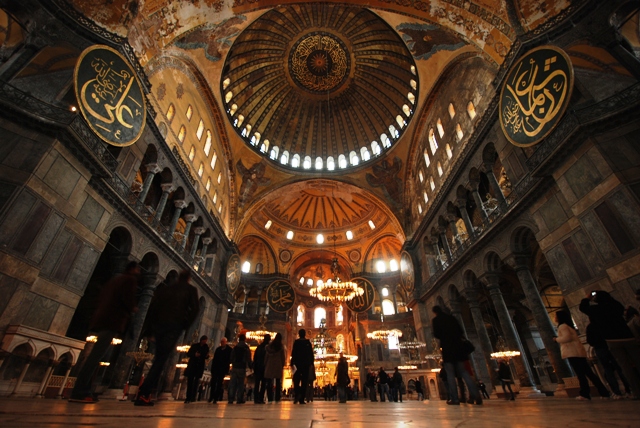In this ancient
country where Europe meets Asia, the sun shines down on a unique fusion of
history and scenery, combining classical ruins, curious rock formations, golden
beaches and tumbledown towns with memorable views; words by James
Bainbridge
Your Trip mapped out
– Delvs into Turkey’s past, from Ottoman splendor in Istanbul to cave dwellings
in Capadocia.
ISTANBUL: Best for Ottoman splendor. The imperial
architecture of a formidable history still wows the crowds against a backdrop of skyscrapers and
modern prosperity.
AYVALIK: Best for
coastal life. Drop the pace down a notch with a visit to the relaxed coastline
of Ayvalik, with this time to savour the fresh cuisine and local spirits.
EPHESUS: Best for
classical ruins. The river may have stopped flowing here but you can still
relive history among the old city’s remarkable Roman buildings and streets.
LYCIAN WAY: Best
for walking. Considered one of the best walks in the world, this epic journey
will take you along ancient trails and closer to the people of the region.
KEKOVA: Best for
a boat trip. Take a traditional sailing boat out to the island of the Sunken
City and step into the submerged Lycian streets, lost nearly 2,000 years ago.
CAPPADOCIA: Best
for horse riding. Mount an Anatolian steed and ride through the distinctive
valleys of Cappadocia, where generations of people have carved homes from the
rocks.
iSTANBUL displays
all the signs of bullish development you’d expect in one of the world’s
fastest-growing economies, with shiny skyscrapers growing ever upward, shops as
far as the eye can see and tankers queueing in the Bosphorus rivers. And yet,
among the organized chaos of this great modern city, ancient mosques and
palaces rise sphinx-like from the jumble of roofs.
For nearly 500 years, Istanbul – or Constantinople as it was
previously know – was the capital of the Ottoman Empire, a powerful regime
that, at its height, stretched from Hungary to Iraq. In the city’s imperial
days, traders sold spices from distant dominions in the bazaars, dignitaries
hunted in parks lining the Bosphorus, and buildings rose to immortalise the
sultans. People came here from across the empire. ‘It was global before there
was ‘global’ ,’says Ottoman historian Caroline Finkel, who has lived in the
city for 25 years.
Standing proud near the city’s spice bazaar is Rustem Pasa Mosque. Built during the
Ottoman Empire, it showcases the best Ottoman architecture and exquisite Iznik
tiles, which cover the walls, columns and the façade of its porch. Rustem Pasa
has a stillness, beauty and calm that offers respite from the glamour of the
markets outside its walls.
On a much grander scale is the famous Blue Mosque, also decorated with Iznik tiles and stained-glass
windows. It lies in the Sultanahmet area, the old town centre that was once the
heart of Ottoman life.
This remarkable mosque was built after the Ottomans took the
city from the Crhistian Byznatine Empire, to compete with the Aya Sofya cathedral, which was a
conspicuous reminder of the old regime. Now a museum, Aya Sofya was made into a
mosque under the Ottomans. ‘It was about imperial rivalry,’ says Caroline,
‘making your own what was there before. Demolishing it by giving new meaning.’
Blue Mosque
Haya Sopya Cathedral
The 1,500-year-old building of Aya Sofya still has a sacred
atmosphere. Turkish families crowd the entrance, craning their necks to view
the soaring ceiling. They wander through the hushed space and queue up at the
weeping column, said to cure ailments with its tears. Ottoman features such as
medallions with gilt Arabic calligraphy draw the eye, but the shadowy corners
are rich with original Christian fragments from the Byzantine era – enduring
signs of Istanbul’s rich past.
Further information:
Entry to the Blue Mosque is free, but it closes for about half an hour at
prayer times (listed at namazvakti.com). The Aya Sofya museum (US$13; muze.gov.tr/hagiasophia) is open Tue-Sun.
Where to Eat:
Istanbul’s premier rooftop bar-restaurant, 360, has views of the old city from
its eight-floor perch. DJs and sporadic performances add to the buzz (dishes
from US$8; 360istanbul.com).
Where to stay: PERA
PALACE HOTEL, opened in 1892, Pera
Palace was the address in Istanbul for guests arriving oon the Orient
Express. Agatha Christie’s novel Murder
on the Orient Express was inspired by her stays in the Ottoman hotel, its
neoclassical façade overlooking the Golden Horn estuary. Completed in September
2010, a two-and-a half-year, US$33m renovation has maintained the elegance of
the eclectic architecture and the grandeur of the public salons. Rooms and
suites reflect their famous past guests. With antique furniture and luxuries
such as hamam like showers, modern comforts mix with vintage style (from
US$365; perapalace.com).














What a lovely views it was so very nice,I love traveling all over the world so much that is why I find travel agents for a vacation trip to discover different views.
ReplyDelete